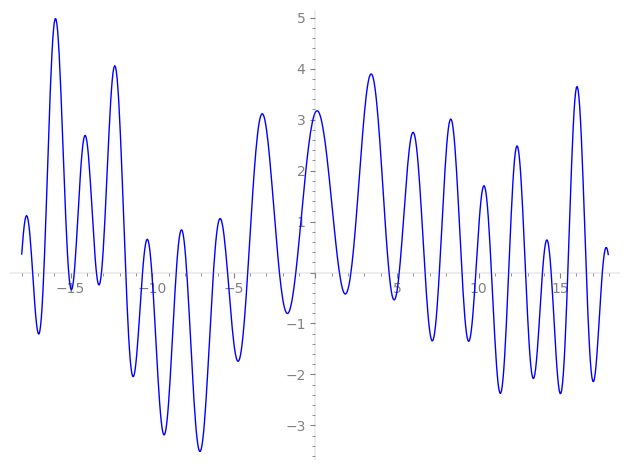| L(s) = 1 | + 0.663i·3-s + 68.6·5-s + 214.·7-s + 242.·9-s + (−95.0 − 389. i)11-s − 556. i·13-s + 45.5i·15-s + 1.84e3i·17-s − 1.21e3·19-s + 142. i·21-s − 121. i·23-s + 1.59e3·25-s + 322. i·27-s − 4.26e3i·29-s − 3.81e3i·31-s + ⋯ |
| L(s) = 1 | + 0.0425i·3-s + 1.22·5-s + 1.65·7-s + 0.998·9-s + (−0.236 − 0.971i)11-s − 0.912i·13-s + 0.0523i·15-s + 1.55i·17-s − 0.772·19-s + 0.0704i·21-s − 0.0478i·23-s + 0.509·25-s + 0.0850i·27-s − 0.942i·29-s − 0.712i·31-s + ⋯ |
Λ(s)=(=(176s/2ΓC(s)L(s)(0.959+0.280i)Λ(6−s)
Λ(s)=(=(176s/2ΓC(s+5/2)L(s)(0.959+0.280i)Λ(1−s)
| Degree: |
2 |
| Conductor: |
176
= 24⋅11
|
| Sign: |
0.959+0.280i
|
| Analytic conductor: |
28.2275 |
| Root analytic conductor: |
5.31296 |
| Motivic weight: |
5 |
| Rational: |
no |
| Arithmetic: |
yes |
| Character: |
χ176(175,⋅)
|
| Primitive: |
yes
|
| Self-dual: |
no
|
| Analytic rank: |
0
|
| Selberg data: |
(2, 176, ( :5/2), 0.959+0.280i)
|
Particular Values
| L(3) |
≈ |
3.146604468 |
| L(21) |
≈ |
3.146604468 |
| L(27) |
|
not available |
| L(1) |
|
not available |
L(s)=p∏Fp(p−s)−1 | p | Fp(T) |
|---|
| bad | 2 | 1 |
| 11 | 1+(95.0+389.i)T |
| good | 3 | 1−0.663iT−243T2 |
| 5 | 1−68.6T+3.12e3T2 |
| 7 | 1−214.T+1.68e4T2 |
| 13 | 1+556.iT−3.71e5T2 |
| 17 | 1−1.84e3iT−1.41e6T2 |
| 19 | 1+1.21e3T+2.47e6T2 |
| 23 | 1+121.iT−6.43e6T2 |
| 29 | 1+4.26e3iT−2.05e7T2 |
| 31 | 1+3.81e3iT−2.86e7T2 |
| 37 | 1−9.38e3T+6.93e7T2 |
| 41 | 1−1.48e4iT−1.15e8T2 |
| 43 | 1+1.82e4T+1.47e8T2 |
| 47 | 1+2.42e4iT−2.29e8T2 |
| 53 | 1−1.80e4T+4.18e8T2 |
| 59 | 1−970.iT−7.14e8T2 |
| 61 | 1−4.83e4iT−8.44e8T2 |
| 67 | 1+9.34e3iT−1.35e9T2 |
| 71 | 1−4.24e4iT−1.80e9T2 |
| 73 | 1+2.18e3iT−2.07e9T2 |
| 79 | 1+4.97e4T+3.07e9T2 |
| 83 | 1−4.08e4T+3.93e9T2 |
| 89 | 1+4.75e3T+5.58e9T2 |
| 97 | 1−4.44e4T+8.58e9T2 |
| show more | |
| show less | |
L(s)=p∏ j=1∏2(1−αj,pp−s)−1
Imaginary part of the first few zeros on the critical line
−11.62607935489166799094571656512, −10.59512636448497832502263847967, −10.02543727399954538091470715772, −8.532139669415176399669783672694, −7.88476031032302004235905838197, −6.25093504625275879612135336707, −5.38489657388937217309436291344, −4.14759072734806914158611171812, −2.20582863164656538486421916617, −1.20128831867993346085127433242,
1.47102498887444616750185326078, 2.17829154922091279569060625761, 4.51432447796725327916328229154, 5.13912228732982786792003259594, 6.71918335104891931419054879438, 7.59604171603703176970584659974, 8.981763396671098018425063798523, 9.831111191739539041898371420527, 10.79029142383358395732323646309, 11.84417028925780767111457830514

